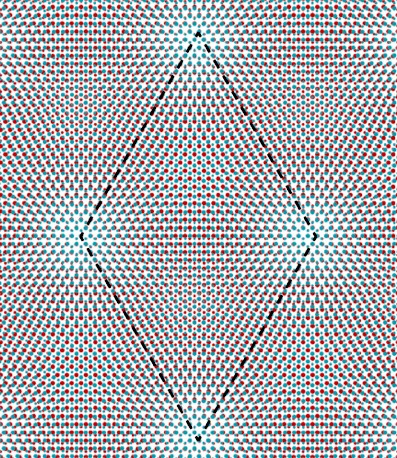To understand the behavior of quantum particles, imagine a pinball game - but rather than one metal ball, there are billions or more, all ricocheting off each other and their surroundings.
Physicists have long tried to study this interactive system of strongly correlated particles, which could help illuminate elusive physics phenomena like high-temperature superconductivity and magnetism.
One classic method is to create a simplified model that can capture the essence of these particle interactions. In 1963, physicists Martin Gutzwiller, Junjiro Kanamori and John Hubbard - working separately - proposed what came to be called the Hubbard model, which describes the essential physics of many interacting quantum particles. The solution to the model, however, only exists in one dimension. For decades, physicists have tried to realize the Hubbard model in two or three dimensions by creating quantum simulators that can mimic it.
Cornell researchers stacked two atomic monolayers of a semiconductor - tungsten disulfide and tungsten diselenide - to create a moiré superlattice that acts as a simulator for the Hubbard model. This simplified system enables the team to better understand the essential physics of many interacting quantum particles.
A Cornell-led collaboration has successfully created such a simulator using ultrathin monolayers that overlap to make a moiré pattern. The team then used this solid-state platform to map a longstanding conundrum in physics: the phase diagram of the triangular lattice Hubbard model.
Their paper, "Simulation of Hubbard Model Physics in WSe2/WS2 Moiré Superlattices," was published March 18 in Nature. The lead author is postdoctoral associate Yanhao Tang.
The project is led by Kin Fai Mak, associate professor of physics in the College of Arts and Sciences and the paper's co-senior author along with Jie Shan, professor of applied and engineering physics in the College of Engineering. Both researchers are members of the Kavli Institute at Cornell for Nanoscale Science, and they came to Cornell through the provost's Nanoscale Science and Molecular Engineering (NEXT Nano) initiative. Their shared lab specializes in the physics of atomically thin quantum materials.
Their lab partnered with co-author Allan MacDonald, a physics professor at the University of Texas at Austin, who in 2018 theorized a Hubbard model simulator would be possible by stacking two atomic monolayers of semiconductors, the sort of materials Mak and Shan have been studying for a decade.
"What we have done is take two different monolayers of this semiconductor, tungsten disulfide (WS2) and tungsten diselenide (WSe2), which have a lattice constant that is slightly different from each other. And when you put one on top of the other, you create a pattern called a moiré superlattice." Mak said.
The moiré superlattice looks like a series of interlocking hexagons, and in each juncture - or site - in the crosshatch pattern, the researchers place an electron. These electrons are usually trapped in place by the energy barrier between the sites. But the electrons have enough kinetic energy that, occasionally, they can hop over the barrier and interact with neighboring electrons.
"If you don't have this interaction, everything is actually well understood and sort of boring," said Mak. "But when the electrons hop around and interact, that's very interesting. That's how you can get magnetism and superconductivity."
Because electrons have a negative charge and repel each other, these ensuing interactions become increasingly complicated when there are so many of them in play - hence the need for a simplified system to understand their behavior.
"We can control the occupation of the electron at each site very precisely," Mak said. "We then measure the system and map out the phase diagram. What kind of magnetic phase is it? How do the magnetic phases depend on the electron density?"
So far, the researchers have used the simulator to make two significant discoveries: observing a Mott insulating state, and mapping the system's magnetic phase diagram. Mott insulators are materials that should behave like metals and conduct electricity, but instead function like insulators - phenomena that physicists predicted the Hubbard model would demonstrate. The magnetic ground state of Mott insulators is also an important phenomena the researchers are continuing to study.
While there are other quantum simulators, such as one that uses cold atom systems and an artificial lattice created by laser beams, Mak says his team's simulator has the distinct advantage of being a "true many-particle simulator" that can easily control - or tune - particle density. The system can also reach much lower effective temperatures and assess the thermodynamic ground states of the model. At the same time, the new simulator is not as successful at tuning the interactions between electrons when they share the same site.
"We want to invent new techniques so that we can also control the on-site repulsion of two electrons," Mak said. "If we can control that, we will have a highly tunable Hubbard model in our lab. We may then obtain the complete phase diagram of the Hubbard model."
Other contributors included Ph.D. student Lizhong Li, postdoctoral associates Tingxin Li and Yang Xu, and researchers from Columbia University and the National Institute for Materials Science in Tsukuba, Japan.
The research was primarily supported by the US Department of Energy.







